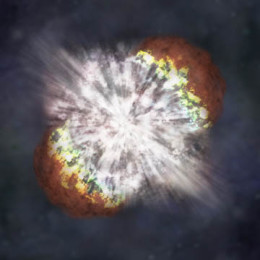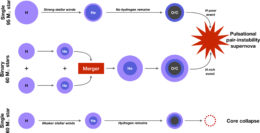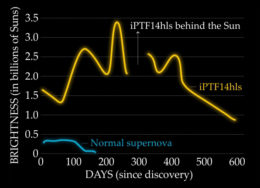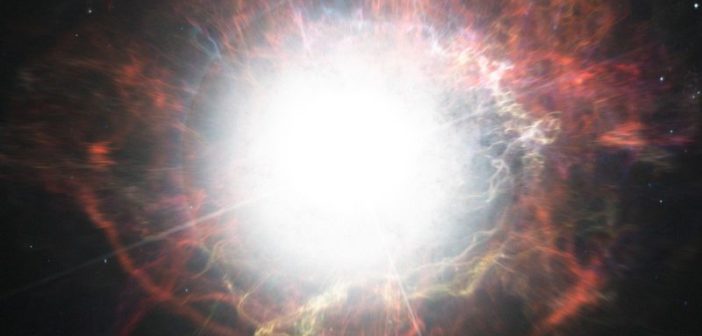Massive stars can die in a lot of different ways! A new study explores one possible channel in more detail.
Detectives Are on the Case

Artist’s illustration of a star exploding in a supernova at the end of its lifetime. [NASA/CXC/M. Weiss]
As we enter the era of ever more expansive sky surveys, we can expect to amass not just evidence of typical stellar deaths, but also some more unusual ones. In the process, piecing together the evidence to solve each mystery becomes progressively more challenging — but also more intriguing!
In a recent study, a team of scientists led by Alejandro Vigna-Gómez (U. of Birmingham, UK; Monash U., Australia; U. of Copenhagen, Denmark) have explored one particular oddball type of theorized stellar death: pulsational pair-instability supernovae (PISNe).
Gravity (Usually) Wins
According to theory, PISNe occur when a very massive (hundreds of solar masses) star gets hot enough to start producing pairs of electrons and positions. This process saps the star’s internal energy, leading to its sudden collapse as the force of gravity triumphs.
This collapse can end in the dramatic explosion of a PISN, or it may lead to a smaller eruption that only sheds some of the star’s mass. In the latter case, the star may go through multiple rounds of smaller eruptions before eventually running out of nuclear fuel and undergoing a final explosion — as a pulsational PISN.

Schematic showing three possible ways massive stars can die; click to enlarge. Top and bottom panels describe outcomes of single-star evolution, depending on the star’s mass. The center channel depicts the merger of two evolved, massive stars to form an object with a large envelope of hydrogen. This can lead to a hydrogen-rich pulsational PISN. [Vigna-Gómez et al. 2019]
Starting with a Merger
If this weren’t complicated enough, Vigna-Gómez and collaborators propose one further twist on this stellar death scenario: the object exploding in a pulsational PISN needn’t simply be a massive star. Instead, it might be the product of the merger of two massive stars.
Vigna-Gómez and collaborators argue that this type of merger is expected to be common, and it would produce a very massive object with a large outer hydrogen shell. By running a series of simulations using the Modules for Experiments in Stellar Astrophysics (MESA), the authors demonstrate that such a merger product could undergo a pulsational PISN and still retain a significant portion of its hydrogen shell up to the final explosion, leaving the fingerprint of hydrogen in the supernova spectrum.
Explanation for a Zombie Star?

The light curve of iPTF14hls is extremely unusual, featuring multiple apparent explosions. [Adapted from Las Cumbres Observatory/S. Wilkinson]
We can’t yet say for sure whether iPTF14hls is an example of a stellar-merger-turned-pulsational-PISN — that will require more extensive modeling and analysis of observations — but Vigna-Gómez and collaborators think it’s a good candidate! And while we wait on the verdict of that mystery, we can be sure that transient surveys are busy finding many more examples of stellar deaths for us to puzzle over.
Citation
“Massive Stellar Mergers as Precursors of Hydrogen-rich Pulsational Pair Instability Supernovae,” Alejandro Vigna-Gómez et al 2019 ApJL 876 L29. doi:10.3847/2041-8213/ab1bdf
